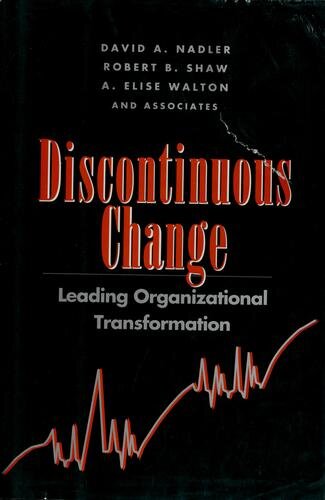David A. Nadler, Robert B. Shaw, A. Elise Walter and Associates. Discontinuous Change: Leading Organizational Transformation. Jossey-Bass, 1995.
Referenced in: Change Concepts and Theories
LifeandLeadership.com Summary
This book is academic, but church leaders willing to wade through it will be exposed to a primary source of change theory found in the literature of complex congregational change. Ministers are notorious for wanting quick access to usable information on change leadership. This is not that book. But for those who want to have a deeper understanding of the dynamics of change, it is a must read. The following highlights the sections most helpful for ministers.
Chapter 2 offers a typology on types of organizational change that have become the standard reference point for many who write about missional transformation in churches, such as the Center for Parish Development’s booklet “Classes of Changes.” This model draws a distinction between “smaller changes that occur during times of equilibrium” and “the changes that occur during times of disequilibrium” (21-22). The first are incremental changes that are “part of a process of constant tinkering, adaptation, and modification as the organization attempts to solve problems and run itself more effectively.” (22) The second are discontinuous changes wherein
“the organization is not trying to improve fit but rather to build a whole new configuration, with a new strategy, a new work, new formal organization arrangements, and so forth. …These changes involve a complete break with the past and a major reconstruction of almost every element of the organization.” (22)
Within this model, another factor is timing (the book has helpful tables for visualization). Some changes anticipate the need for change and precede the situation they plan to address, thus they are anticipatory. Others react to shifts in the external environment and come after the situation they address, thus they are reactive. Furthermore, there are two types of anticipatory change, one that is incremental, tuning, and another that is discontinuous, reorientation. Also, there are two types of reactive change, one that is incremental, adapting, and the other that is discontinuous, recreating. These four types of change are explained in great detail. Any church leader who reads their descriptions will find them enlightening, especially read alongside the Center for Parish Development booklet I mentioned above.
Here’s the key point: one’s approach to change differs significantly depending on the type of change. Part One includes Chapter 3 describes the challenges inherent in each type. Part Two starts with Chapter 4, which explains the issues of resistance, control and power, and how to motivate and manage transitions and politics in the face of each. Chapters 5 and 6 discuss how to lead discontinuous changes through the various stages. Chapter 7 instructs how to sustain change and create a resilient organization by managing the emotional realities, restoring faith and confidence, forming supportive teams, fostering organizational dialogue, and promoting organizational learning. Part Three shifts the discussion to key leverage points for change. It addresses change in light of business settings whose controls and incentives are considerably different than churches, but church leaders may still find useful material.
From the Publisher
How have leaders of change in companies like American Express, AT&T, Ford, and Xerox successfully navigated the often frightening and turbulent seas of large-scale change? Based on the authors’ ten years of consulting experience with corporations facing organizational upheavals, Discontinuous Change is designed to build a diagnostic framework for understanding, managing, and evaluating change. The authors explore the key issues of effective leadership, culture change, motivating employees and overcoming resistance, and finding ways to sustain competitiveness by initiating, not just responding to, change.
Explores the practical lessons learned from internationally renowned companies to bring about lasting and fundamental organizational transformation, providing a useful set of field-tested concepts and techniques for anyone seeking to promote change. In-depth interviews with such key corporate change leaders as Bob Allen of AT&T and Jamie Houghton of Corning, Inc., provide valuable insight and firsthand advice on the role CEOs and leadership teams can play in organizational transformation
About the Authors
A. ELISE WALTON and Associate are members of Delta Consulting Group, a New York-based firm whose practice focuses on the management of strategic organizational change. Nadler and Shaw are coauthors (with Marc S. Gerstein) of Organizational Architecture: Designs for Changing Organizations (Jossey-Bass 1992). Nadler is also coauthor (with David Kearns) of Prophets in the Dark: How Xerox Reinvented Itself and Beat Back the Japanese (1993).
***For additional information on this resource, including reviews, click the bookstore links. Check the reference at page top or the links below for resource guides on related topics.***
Related Areas
See Other Resources on Change and Transition in Churches:
- Change and Transition in Churches, Intro
- Change Concepts and Theories
- Change Receptiveness and Resistance
- Leading Change and Transition
See Resource Guides on Over 100 Areas of Ministry Leadership:


